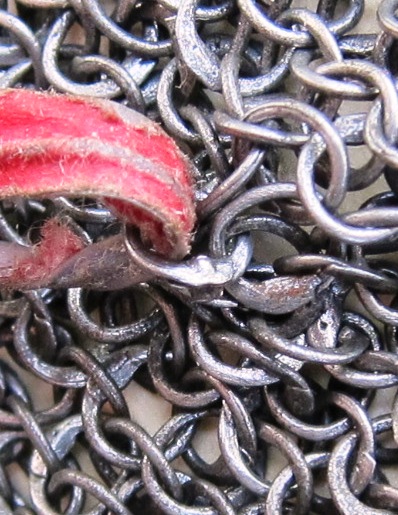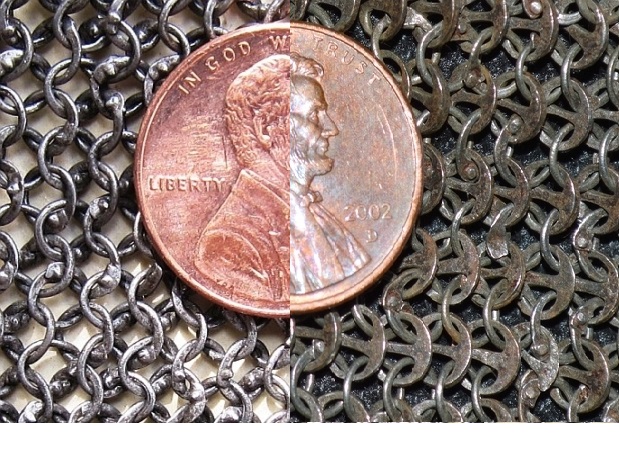
Alright, after some fooling around I have split imaged the two mails. My penny is still a smidge bigger than Eric's, which means my mail is a further smidge smaller yet, but it shows better the diffference in size. Eric's is mighty fine, but mine is finer still!
 Attachment: 165.79 KB
Attachment: 165.79 KB


Putting calipers to screen, and doing a little division, it looks like James rings are right around 4 mm outer diameter.
| Mart Shearer wrote: |
| Putting calipers to screen, and doing a little division, it looks like James rings are right around 4 mm outer diameter. |
3/16 inch = 0.1875 inch decimal, 0.1875 inch decimal = 4.7625 mm (0.47625 cm)
Indian khula khud (mail hood / coif), 16th to 18th century, alternating theta link and theta link, detail view of a riveted link (top) and a theta link (bottom).
[ Linked Image ]
[ Linked Image ]
Last edited by Eric S on Wed 17 Sep, 2014 8:02 am; edited 1 time in total
I am putting some information from a thread on this forum and a thread from another forum together here. Mart posted some information on Wade Allens hauberk M2. ( http://www.allenantiques.com/M-2.html ) It is a long horsemans type with a split up the front and back, all European wedge riveted mail, it has been suggested that the mail is 14th or early 15th (possibly Milanese).
I noticed a similarity between Wade Allens M2 hauberk and three other hauberks that I know of, these were also of the same type with a long split up the front and back. All four have some similarities and differences, it has been suggested that possibly all or some of these hauberks were either made for or sold to the Indo-Persian market. There is evidence of trade between European countries and several Indo-Persian countries in both arms and armor.
All four have a long front and back split and a split at the collar, three of the hauberks have similar standing leather collars, all four appear to be made with wedge riveted mail with one of the four having alternating wedge rivets and solid links, two have a wide flat area at the top of the front and back splits which looks typically Indo-Persian. The outer rivet heads on all four hauberks are very worn, to the point that the metal appears to be smooth and the rivet heads look like small rounded bumps instead of being pronounced, showing age and use. So far two of the hauberks have been said to possibly be constructed with Italian mail with a time period ranging from 14th or early 15th century on one to 15th to 16th century for the other, two have no opinions yet on age or origin. Two have been weighed one was 16 lbs, the other 18 lbs.
Here are some photographs of the four hauberks along with some detailed images of the links.
Wade Allens hauberk M2 is top left.
[ Linked Image ]
#1. Wade Allens M2, 16 lbs.
[ Linked Image ]
[ Linked Image ]
#2. Wedge riveted with alternating solid links, 18 lbs.
[ Linked Image ]
[ Linked Image ]
#3. [ Linked Image ]
[ Linked Image ]
#4. [ Linked Image ]
[ Linked Image ]
I noticed a similarity between Wade Allens M2 hauberk and three other hauberks that I know of, these were also of the same type with a long split up the front and back. All four have some similarities and differences, it has been suggested that possibly all or some of these hauberks were either made for or sold to the Indo-Persian market. There is evidence of trade between European countries and several Indo-Persian countries in both arms and armor.
All four have a long front and back split and a split at the collar, three of the hauberks have similar standing leather collars, all four appear to be made with wedge riveted mail with one of the four having alternating wedge rivets and solid links, two have a wide flat area at the top of the front and back splits which looks typically Indo-Persian. The outer rivet heads on all four hauberks are very worn, to the point that the metal appears to be smooth and the rivet heads look like small rounded bumps instead of being pronounced, showing age and use. So far two of the hauberks have been said to possibly be constructed with Italian mail with a time period ranging from 14th or early 15th century on one to 15th to 16th century for the other, two have no opinions yet on age or origin. Two have been weighed one was 16 lbs, the other 18 lbs.
Here are some photographs of the four hauberks along with some detailed images of the links.
Wade Allens hauberk M2 is top left.
[ Linked Image ]
#1. Wade Allens M2, 16 lbs.
[ Linked Image ]
[ Linked Image ]
#2. Wedge riveted with alternating solid links, 18 lbs.
[ Linked Image ]
[ Linked Image ]
#3. [ Linked Image ]
[ Linked Image ]
#4. [ Linked Image ]
[ Linked Image ]
Just realized I posted the wrong link earlier. Here's the right one. http://www.livinghistory.cz/node/426 For the ring sizes, I think the first number is outside diameter for riveted, second number is for solids, and last two is wire thickness for both.
Of rival size, plus having the complication of interwoven scales, is the Roman lorica hamata squamataque (mail and scale armor) -- H. R. Robinson's "plumata". Here's the Newstead find:
[ Linked Image ]
[ Linked Image ]
| Mart Shearer wrote: |
| Of rival size, plus having the complication of interwoven scales, is the Roman lorica hamata squamataque (mail and scale armor) -- H. R. Robinson's "plumata". Here's the Newstead find:
[ Linked Image ] |
Well this is something new for me! How would this armour look like when new? Any interpretations?
| Luka Borscak wrote: |
| Well this is something new for me! How would this armour look like when new? Any interpretations? |
Erik made a reconstruction. The entire second issue of the MRS journal is devoted to this armour. Original subscribers received a small patch of his reconstruction.
James,
I found a ring like that on one of Wade Allen's mail sleeves. It's remarkable that the rivet is still there, even though it has never been properly squashed. It suggests that the rivets are jammed it pretty hard I (somehow) before the final setting process.
In both this example and the one from Wade's collection, the exposed base of the rivet seems surprisingly large. I guess that goes to show what I don't know about mail rivets. :confused:
Mac
I found a ring like that on one of Wade Allen's mail sleeves. It's remarkable that the rivet is still there, even though it has never been properly squashed. It suggests that the rivets are jammed it pretty hard I (somehow) before the final setting process.
In both this example and the one from Wade's collection, the exposed base of the rivet seems surprisingly large. I guess that goes to show what I don't know about mail rivets. :confused:
Mac
In this detail (just to the left of the ring with the rivet hanging out) we can see the base of a rivet which appears not to have been spread at all in the setting. I get the impression that we can see the original dimensions of the base of the rivet as well as those of the slot it was installed into.
[ Linked Image ]
Mac
[ Linked Image ]
Mac
| James Arlen Gillaspie wrote: |
| Alright, after some fooling around I have split imaged the two mails. My penny is still a smidge bigger than Eric's, which means my mail is a further smidge smaller yet, but it shows better the diffference in size. Eric's is mighty fine, but mine is finer still! |
James, if Mart is correct and the mail you have posted images of is 4 mm outer diameter then it may well be the smallest known riveted mail example, I have looked through the mail images I have with known measurements but have not found any that is the same or smaller diameter.
| Robert MacPherson wrote: |
| In this detail (just to the left of the ring with the rivet hanging out) we can see the base of a rivet which appears not to have been spread at all in the setting. I get the impression that we can see the original dimensions of the base of the rivet as well as those of the slot it was installed into.
[ Linked Image ] Mac |
Were the rivets set in the back side, due to their shape they would have not been able to go forward and with the head of the rivet set it could not have moved backwards. Were the tolerances so tight that just inserting the rivet into the slot basically set it without having to spread it out.
[ Linked Image ]
What I find interesting in that pic, Eric is that we seem to be seeing the un-deformed original size of the rivet and its slot. I'm excited because his tells us something about the process and the tools. I suspect that this particular rivet was too narrow, and thus entered the slot all the way. This left nothing at all sticking out the back to be upset by the setting process. By contrast, the one that James marked looks like the rivet is much wider.
As you say, the tapered shape makes it so that the rivets jam in the slots. I think that they usually jam with just a bit of material sticking out the back. This excess gets upset and otherwise smooshed down in the setting process to produce that smooth, almost featureless look on the back.
Mac
As you say, the tapered shape makes it so that the rivets jam in the slots. I think that they usually jam with just a bit of material sticking out the back. This excess gets upset and otherwise smooshed down in the setting process to produce that smooth, almost featureless look on the back.
Mac
| Robert MacPherson wrote: |
| What I find interesting in that pic, Eric is that we seem to be seeing the un-deformed original size of the rivet and its slot. I'm excited because his tells us something about the process and the tools. I suspect that this particular rivet was too narrow, and thus entered the slot all the way. This left nothing at all sticking out the back to be upset by the setting process. By contrast, the one that James marked looks like the rivet is much wider.
As you say, the tapered shape makes it so that the rivets jam in the slots. I think that they usually jam with just a bit of material sticking out the back. This excess gets upset and otherwise smooshed down in the setting process to produce that smooth, almost featureless look on the back. Mac |
Mac, to me it looks like there are a lot of rivet slots showing.
[ Linked Image ]
It's true, Eric. Looking at the others, I am no longer so sure that my favorite one is all that pristine. It looks like it might have gotten squeezed a bit narrower in the setting process.
Mac
Mac
| Robert MacPherson wrote: |
| It's true, Eric. Looking at the others, I am no longer so sure that my favorite one is all that pristine. It looks like it might have gotten squeezed a bit narrower in the setting process.
Mac |
Mac, I am beginning to wonder if the lack of detailed images from the back side of the links on most armors that we end up seeing online has improperly shaped what we think the back of the link should look like, maybe more of them actually show the rivet like the one James has, we just do not have enough images to know for sure.
Take the Sinigaglia hauberk as an example, a very famous armor that has been throughly examined, written about and photographed and yet I can not find a single image of the back of the links. Here we have a very rare alternating wedge rivet and solid link hauberk and you can only see it from the front side. Museums and auction houses do not normally show the back side of the links of hauberks, its mostly through the images provided by private individuals that we are able to see this aspect of riveted mail. Here is one example from a museum, they mistakenly displayed their bishops mantle inside out, giving us the opportunity to see what normally would be hidden.
| Quote: |
| European riveted mail bishops mantle (pellegrina di maglia anelli), detail view of the shoulder, 16th century, wedge rivets with bands of brass links, this armor is being displayed inside out as the wedge shaped rivets would normally not be seen on the outside, Museo delle Armi "Luigi Marzoli" (Brescia) Italy. |
[ Linked Image ]
Last edited by Eric S on Thu 18 Sep, 2014 9:00 am; edited 1 time in total
I got some photos of holes from missing and sprung rivets last June at Wade's. (Thanks to Tom Biliter for placing the mm scale!) The drifts seem to have been ground to a trapezoidal section or a very flat pentagon. When filled with a nearly rectangular rivet section, these usually leave a sharp corner visible on the inside of the ring, and sometimes a slit to either side of the rivet head on the outside.
 Attachment: 92.94 KB
Attachment: 92.94 KB
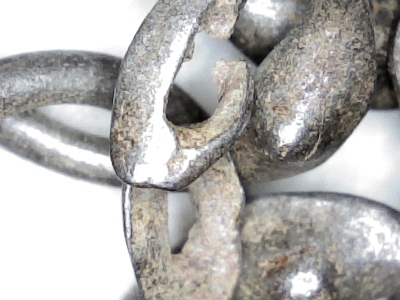
Allen M-2
 Attachment: 104.8 KB
Attachment: 104.8 KB
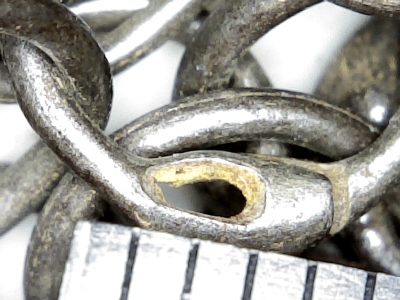
Allen M-2
 Attachment: 115.43 KB
Attachment: 115.43 KB
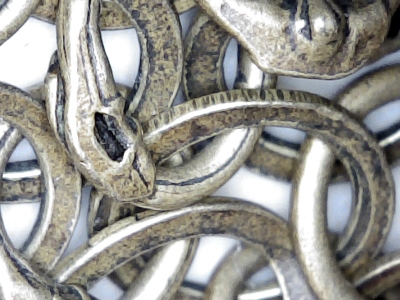
Allen M-4

Allen M-2

Allen M-2

Allen M-4
| Robert MacPherson wrote: |
| James,
I found a ring like that on one of Wade Allen's mail sleeves. It's remarkable that the rivet is still there, even though it has never been properly squashed. It suggests that the rivets are jammed it pretty hard I (somehow) before the final setting process. In both this example and the one from Wade's collection, the exposed base of the rivet seems surprisingly large. I guess that goes to show what I don't know about mail rivets. :confused: Mac |
I recently found this failed link with an intact wedge rivet.
[ Linked Image ]
Those are great pics, guys!
It goes to show how much volume the wedge-rivet contributes to the joint. It also shows how much deformation it must undergo during the setting.
Mac
It goes to show how much volume the wedge-rivet contributes to the joint. It also shows how much deformation it must undergo during the setting.
Mac
Page 11 of 27
You cannot post new topics in this forumYou cannot reply to topics in this forum
You cannot edit your posts in this forum
You cannot delete your posts in this forum
You cannot vote in polls in this forum
You cannot attach files in this forum
You can download files in this forum
All contents © Copyright 2003-2006 myArmoury.com — All rights reserved
Discussion forums powered by phpBB © The phpBB Group
Switch to the Full-featured Version of the forum
Discussion forums powered by phpBB © The phpBB Group
Switch to the Full-featured Version of the forum
